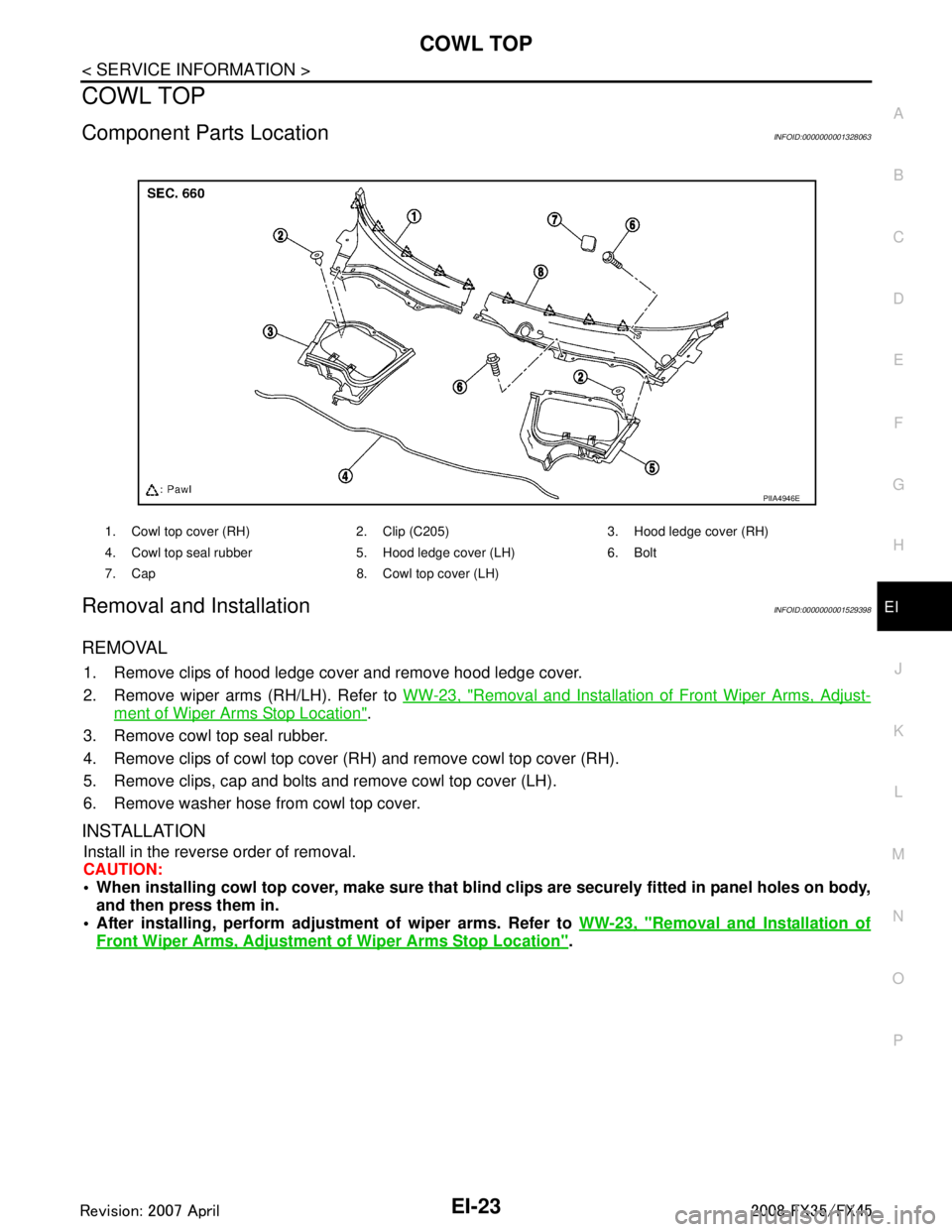2008 INFINITI FX35 seal
[x] Cancel search: sealPage 2013 of 3924
![INFINITI FX35 2008 Service Manual
DTC P0102, P0103 MAF SENSOREC-773
< SERVICE INFORMATION > [VK45DE]
C
D
E
F
G H
I
J
K L
M A
EC
NP
O
8.CHECK MASS AIR FLOW SENSOR
Refer to EC-773, "
Component Inspection".
OK or NG
OK >> GO TO 9.
NG > INFINITI FX35 2008 Service Manual
DTC P0102, P0103 MAF SENSOREC-773
< SERVICE INFORMATION > [VK45DE]
C
D
E
F
G H
I
J
K L
M A
EC
NP
O
8.CHECK MASS AIR FLOW SENSOR
Refer to EC-773, "
Component Inspection".
OK or NG
OK >> GO TO 9.
NG >](/manual-img/42/57017/w960_57017-2012.png)
DTC P0102, P0103 MAF SENSOREC-773
< SERVICE INFORMATION > [VK45DE]
C
D
E
F
G H
I
J
K L
M A
EC
NP
O
8.CHECK MASS AIR FLOW SENSOR
Refer to EC-773, "
Component Inspection".
OK or NG
OK >> GO TO 9.
NG >> Replace mass air flow sensor.
9.CHECK INTERMITTENT INCIDENT
Refer to EC-717
.
>> INSPECTION END
Component InspectionINFOID:0000000001326601
MASS AIR FLOW SENSOR
With CONSULT-III
1. Reconnect all harness connectors disconnected.
2. Start engine and warm it up to normal operating temperature.
3. Connect CONSULT-III and select “DATA MONITOR” mode.
4. Select “MAS A/F SE-B1” and check i ndication under the following conditions.
*: Check for linear voltage rise in response to engine being increased to about 4,000 rpm.
5. If the voltage is out of specification, proceed the following.
a. Check for the cause of uneven air flow through mass air flow sensor. Refer to following. Crushed air ducts
Malfunctioning seal of air cleaner element
Uneven dirt of air cleaner element
Improper specification of intake air system parts
b. If NG, repair or replace malfunctioning part and perform step 2 to 4 again. If OK, go to next step.
6. Turn ignition switch OFF.
7. Disconnect mass air flow sensor har ness connector and reconnect it again.
8. Perform step 2 to 4 again.
9. If NG, clean or replace mass air flow sensor.
Without CONSULT-III
1. Reconnect all harness connectors disconnected.
2. Start engine and warm it up to normal operating temperature.
Condition MAS A/F SE-B1 (V)
Ignition switch ON (Engine stopped.) Approx. 0.4
Idle (Engine is warmed-up to normal
operating temperature.) 1.0 - 1.3
2,500 rpm (Engine is warmed-up to
normal operating temperature.) 1.6 - 2.0
Idle to about 4,000 rpm 1.0 - 1.3 to Approx. 2.4*
3AA93ABC3ACD3AC03ACA3AC03AC63AC53A913A773A893A873A873A8E3A773A983AC73AC93AC03AC3
3A893A873A873A8F3A773A9D3AAF3A8A3A8C3A863A9D3AAF3A8B3A8C
Page 2014 of 3924
![INFINITI FX35 2008 Service Manual
EC-774
< SERVICE INFORMATION >[VK45DE]
DTC P0102, P0103 MAF SENSOR
3. Check voltage between ECM terminal 51 (Mass air flow sensor
signal) and ground.
*: Check for linear voltage rise in response to e INFINITI FX35 2008 Service Manual
EC-774
< SERVICE INFORMATION >[VK45DE]
DTC P0102, P0103 MAF SENSOR
3. Check voltage between ECM terminal 51 (Mass air flow sensor
signal) and ground.
*: Check for linear voltage rise in response to e](/manual-img/42/57017/w960_57017-2013.png)
EC-774
< SERVICE INFORMATION >[VK45DE]
DTC P0102, P0103 MAF SENSOR
3. Check voltage between ECM terminal 51 (Mass air flow sensor
signal) and ground.
*: Check for linear voltage rise in response to engine being increased to about 4,000 rpm.
4. If the voltage is out of spec ification, proceed the following.
a. Check for the cause of uneven air flow through mass air flow sensor. Refer to following. Crushed air ducts
Malfunctioning seal of air cleaner element
Uneven dirt of air cleaner element
Improper specification of intake air system parts
b. If NG, repair or replace malfunctioning part and perform step 2 and 3 again. If OK, go to next step.
5. Turn ignition switch OFF.
6. Disconnect mass air flow sensor harness connector and reconnect it again.
7. Perform step 2 and 3 again.
8. If NG, clean or replace mass air flow sensor.
Removal and InstallationINFOID:0000000001326602
MASS AIR FLOW SENSOR
Refer to EM-173.
Condition Voltage V
Ignition switch ON (Engine stopped.) Approx. 0.4
Idle (Engine is warmed-up to normal
operating temperature.) 1.0 - 1.3
2,500 rpm (Engine is warmed-up to
normal operating temperature.) 1.6 - 2.0
Idle to about 4,000 rpm 1.0 - 1.3 to Approx. 2.4*
PBIB1106E
3AA93ABC3ACD3AC03ACA3AC03AC63AC53A913A773A893A873A873A8E3A773A983AC73AC93AC03AC3
3A893A873A873A8F3A773A9D3AAF3A8A3A8C3A863A9D3AAF3A8B3A8C
Page 2036 of 3924
![INFINITI FX35 2008 Service Manual
EC-796
< SERVICE INFORMATION >[VK45DE]
DTC P0128 THERMOSTAT FUNCTION
DTC P0128 THERMOSTAT FUNCTION
On Board Diagn
osis LogicINFOID:0000000001326637
Engine coolant temperature has not risen enough to INFINITI FX35 2008 Service Manual
EC-796
< SERVICE INFORMATION >[VK45DE]
DTC P0128 THERMOSTAT FUNCTION
DTC P0128 THERMOSTAT FUNCTION
On Board Diagn
osis LogicINFOID:0000000001326637
Engine coolant temperature has not risen enough to](/manual-img/42/57017/w960_57017-2035.png)
EC-796
< SERVICE INFORMATION >[VK45DE]
DTC P0128 THERMOSTAT FUNCTION
DTC P0128 THERMOSTAT FUNCTION
On Board Diagn
osis LogicINFOID:0000000001326637
Engine coolant temperature has not risen enough to open the thermostat even though the engine has run long
enough.
This is due to a leak in the seal or the thermostat stuck open.
DTC Confirmation ProcedureINFOID:0000000001326638
NOTE:
If DTC Confirmation Procedure has been previously conduc ted, always turn ignition switch OFF and wait at
least 10 seconds before conducting the next test.
TESTING CONDITION:
For best results, perform at ambient temperature of –10 °C (14 °F) or higher.
For best results, perform at en gine coolant temperature of –10 °C (14 °F) to 71 °C (160 °F).
Before performing the following procedure, do not fill with the fuel.
WITH CONSULT-III
1. Turn A/C switch OFF.
2. Turn blower fan switch OFF.
3. Turn ignition switch ON.
4. Select “COOLAN TEMP/S” in “DATA MONITOR” mode with CONSULT-III.
5. Check the indication of “COOLAN TEMP/S”.
If it is below 71 °C (160 °F), go to following step.
If it is above 71 °C (160 °F), cool down the engine to less than 71 °C (160 °F), then go to next step.
6. Start engine.
7. Wait at idle for a least 30 minutes. If “COOLAN TEMP/S” increases to more than 71 °C (160 °F) within 30 minutes, turn ignition switch
OFF because the test result will be OK.
8. Check 1st trip DTC.
9. If 1st trip DTC is detected, go to EC-796, "
Diagnosis Procedure".
WITH GST
Follow the procedure “WITH CONSULT-III” above.
Diagnosis ProcedureINFOID:0000000001326639
1.CHECK ENGINE COOLANT TEMPERATURE SENSOR
Refer to EC-797, "
Component Inspection".
OK or NG
OK >> GO TO 2.
NG >> Replace engine coolant temperature sensor.
2.CHECK THERMOSTST
Refer to CO-53, "
Removal and Installation".
OK or NG
OK >> INSPECTION END
NG >> Replace thermostat.
DTC No. Trouble diagnosis name DTC detecting condition Possible cause
P0128
0128 Thermostat function The engine coolant temperature does not reach
to specified temperature even though the en-
gine has run long enough. Thermostat
Leakage from sealing portion of thermo-
stat
Engine coolant temperature sensor
3AA93ABC3ACD3AC03ACA3AC03AC63AC53A913A773A893A873A873A8E3A773A983AC73AC93AC03AC3
3A893A873A873A8F3A773A9D3AAF3A8A3A8C3A863A9D3AAF3A8B3A8C
Page 2186 of 3924
![INFINITI FX35 2008 Service Manual
EC-946
< SERVICE INFORMATION >[VK45DE]
DTC P0447 EVAP CANISTER VENT CONTROL VALVE
DTC P0447 EVAP CANISTER VENT CONTROL VALVE
Component DescriptionINFOID:0000000001326782
The EVAP canister vent contro INFINITI FX35 2008 Service Manual
EC-946
< SERVICE INFORMATION >[VK45DE]
DTC P0447 EVAP CANISTER VENT CONTROL VALVE
DTC P0447 EVAP CANISTER VENT CONTROL VALVE
Component DescriptionINFOID:0000000001326782
The EVAP canister vent contro](/manual-img/42/57017/w960_57017-2185.png)
EC-946
< SERVICE INFORMATION >[VK45DE]
DTC P0447 EVAP CANISTER VENT CONTROL VALVE
DTC P0447 EVAP CANISTER VENT CONTROL VALVE
Component DescriptionINFOID:0000000001326782
The EVAP canister vent control
valve is located on the EVAP canis-
ter and is used to seal the canister vent.
This solenoid valve responds to signals from the ECM. When the
ECM sends an ON signal, the coil in the solenoid valve is energized.
A plunger will then move to seal the canister vent. The ability to seal
the vent is necessary for the on board diagnosis of other evaporative
emission control system components.
This solenoid valve is used only for diagnosis, and usually remains
opened.
When the vent is closed, under normal purge conditions, the evapo-
rative emission control system is depressurized and allows “EVAP
Control System” diagnosis.
CONSULT-III Reference Value in Data Monitor ModeINFOID:0000000001326783
Specification data are reference values.
On Board Diagn osis LogicINFOID:0000000001326784
DTC Confirmation ProcedureINFOID:0000000001326785
NOTE:
If DTC Confirmation Procedure has been previously conduc ted, always turn ignition switch OFF and wait at
least 10 seconds before conducting the next test.
TESTING CONDITION:
Before performing the following procedure, conf irm battery voltage is more than 11V at idle.
1. Start engine and wait at least 8 seconds.
2. Check 1st trip DTC.
3. If 1st trip DTC is detected, go to EC-948, "
Diagnosis Procedure".
PBIB1263E
PBIB1522E
MONITOR ITEM CONDITION SPECIFICATION
VENT CONT/V Ignition switch: ON OFF
DTC No. Trouble diagnosis name DTC detecting condition Possible cause
P0447
0447 EVAP canister vent con-
trol valve circuit open An improper voltage signal is sent to ECM
through EVAP canister vent control valve. Harness or connectors
(The valve circuit is open or shorted.)
EVAP canister vent control valve
3AA93ABC3ACD3AC03ACA3AC03AC63AC53A913A773A893A873A873A8E3A773A983AC73AC93AC03AC3
3A893A873A873A8F3A773A9D3AAF3A8A3A8C3A863A9D3AAF3A8B3A8C
Page 2191 of 3924
![INFINITI FX35 2008 Service Manual
DTC P0448 EVAP CANISTER VENT CONTROL VALVE
EC-951
< SERVICE INFORMATION > [VK45DE]
C
D
E
F
G H
I
J
K L
M A
EC
NP
O
DTC P0448 EVAP CANISTER
VENT CONTROL VALVE
Component DescriptionINFOID:000000000132 INFINITI FX35 2008 Service Manual
DTC P0448 EVAP CANISTER VENT CONTROL VALVE
EC-951
< SERVICE INFORMATION > [VK45DE]
C
D
E
F
G H
I
J
K L
M A
EC
NP
O
DTC P0448 EVAP CANISTER
VENT CONTROL VALVE
Component DescriptionINFOID:000000000132](/manual-img/42/57017/w960_57017-2190.png)
DTC P0448 EVAP CANISTER VENT CONTROL VALVE
EC-951
< SERVICE INFORMATION > [VK45DE]
C
D
E
F
G H
I
J
K L
M A
EC
NP
O
DTC P0448 EVAP CANISTER
VENT CONTROL VALVE
Component DescriptionINFOID:0000000001326789
The EVAP canister vent control valve is located on the EVAP canis-
ter and is used to seal the canister vent.
This solenoid valve responds to signals from the ECM. When the
ECM sends an ON signal, the coil in the solenoid valve is energized.
A plunger will then move to seal the canister vent. The ability to seal
the vent is necessary for the on board diagnosis of other evaporative
emission control system components.
This solenoid valve is used only for diagnosis, and usually remains
opened.
When the vent is closed, under normal purge conditions, the evapo-
rative emission control system is depressurized and allows EVAP
Control System diagnosis.
CONSULT-III Reference Val ue in Data Monitor ModeINFOID:0000000001326790
Specification data are reference values.
On Board Diagnosis LogicINFOID:0000000001326791
DTC Confirmation ProcedureINFOID:0000000001326792
NOTE:
If DTC Confirmation Procedure has been previously conduc ted, always turn ignition switch OFF and wait at
least 10 seconds before conducting the next test.
WITH CONSULT-III
1. Turn ignition switch ON and wait at least 5 seconds.
2. Turn ignition switch OFF and wait at least 10 seconds.
3. Start engine and let it idle for at least 1 minute.
4. Repeat next procedures 3 times.
a. Increase the engine speed up to 3,000 to 3,500 rpm and keep it for 2 minutes and 50 seconds to 3 min-
utes.
Never exceed 3 minutes.
PBIB1263E
PBIB1522E
MONITOR ITEM CONDITION SPECIFICATION
VENT CONT/V Ignition switch: ON OFF
DTC No. Trouble diagnosis name DTC detecting condition Possible cause
P0448
0448 EVAP canister vent con-
trol valve close EVAP canister vent control valve remains
closed under specified driving conditions. EVAP canister vent control valve
EVAP control system pressure sensor
and the circuit
Blocked rubber tube to EVAP canister vent control valve
EVAP canister is saturated with water
3AA93ABC3ACD3AC03ACA3AC03AC63AC53A913A773A893A873A873A8E3A773A983AC73AC93AC03AC3
3A893A873A873A8F3A773A9D3AAF3A8A3A8C3A863A9D3AAF3A8B3A8C
Page 2438 of 3924

EI-1
BODY
C
DE
F
G H
J
K L
M
SECTION EI
A
B
EI
N
O P
CONTENTS
EXTERIOR & INTERIOR
SERVICE INFORMATION .. ..........................3
PRECAUTIONS .............................................. .....3
Precaution for Supplemental Restraint System
(SRS) "AIR BAG" and "SEAT BELT PRE-TEN-
SIONER" ............................................................. ......
3
Precaution for Procedure without Cowl Top Cover ......3
Precaution for Work ..................................................3
PREPARATION ...................................................4
Special Service Tool ........................................... ......4
Commercial Service Tool ..........................................4
SQUEAK AND RATTLE TROUBLE DIAG-
NOSES ................................................................
5
Work Flow ........................................................... ......5
Generic Squeak and Rattle Troubleshooting ............7
Diagnostic Worksheet ...............................................9
CLIP AND FASTENER .......................................11
Clip and Fastener ................................................ ....11
FRONT BUMPER ...............................................14
Component Parts Location .................................. ....14
Removal and Installation .........................................15
REAR BUMPER .................................................17
Component Parts Location .................................. ....17
Removal and Installation .........................................18
FRONT GRILLE .................................................22
Component Parts Location .................................. ....22
Removal and Installation .........................................22
COWL TOP .........................................................23
Component Parts Location .................................. ....23
Removal and Installation .........................................23
FENDER PROTECTOR ......................................24
Component Parts Location .................................. ....24
Removal and Installation .........................................24
DOOR OUTSIDE MOLDING .............................25
Component Parts Location .................................. ....25
Removal and Installation .........................................25
DOOR OUTSIDE LOWER MOLDING ...............26
Component Parts Location ......................................26
Removal and Installation .........................................26
DOOR PARTING SEAL ....................................27
Component Parts Location ......................................27
Removal and Installation .........................................27
CENTER MUD GUARD .....................................29
Component Parts Location ......................................29
Removal and Installation .........................................29
WINDSHIELD MOLDING ..................................30
Component Parts Location ......................................30
Removal and Installation .........................................30
BACK DOOR WINDOW MOLDING ..................31
Component Parts Location .................................. ....31
Removal and Installation .........................................31
ROOF SIDE MOLDING .....................................32
Component Parts Location ......................................32
Removal and Installation .........................................32
ROOF RAIL .......................................................33
Component Parts Location ......................................33
Removal and Installation .........................................33
BACK DOOR FINISHER ...................................35
Component Parts Location ......................................35
Removal and Installation .........................................35
DOOR FINISHER ..............................................36
Component Parts Location ......................................36
Removal and Installation .........................................36
BODY SIDE TRIM .............................................38
Component Parts Location ......................................38
Removal and Installation .........................................38
3AA93ABC3ACD3AC03ACA3AC03AC63AC53A913A773A893A873A873A8E3A773A983AC73AC93AC03AC3
3A893A873A873A8F3A773A9D3AAF3A8A3A8C3A863A9D3AAF3A8B3A8C
Page 2445 of 3924

EI-8
< SERVICE INFORMATION >
SQUEAK AND RATTLE TROUBLE DIAGNOSES
Most of these incidents can be repaired by adjusting, securing or insulating the item(s) or component(s) caus-
ing the noise.
SUNROOF/HEADLINING
Noises in the sunroof/headlining area c an often be traced to one of the following:
1. Sunroof lid, rail, linkage or seals making a rattle or light knocking noise
2. Sun-visor shaft shaking in the holder
3. Front or rear windshield touching headlining and squeaking
Again, pressing on the components to stop the noise while duplicating the conditions can isolate most of these
incidents. Repairs usually consist of insulating with felt cloth tape.
SEATS
When isolating seat noise it's important to note the pos ition the seat is in and the load placed on the seat when
the noise is present. These conditions should be dupl icated when verifying and isolating the cause of the
noise.
Cause of seat noise include:
1. Headrest rods and holder
2. A squeak between the seat pad cushion and frame
3. The rear seatback lock and bracket
These noises can be isolated by moving or pressing on the suspected components while duplicating the con-
ditions under which the noise occurs. Most of thes e incidents can be repaired by repositioning the component
or applying urethane tape to the contact area.
UNDERHOOD
Some interior noise may be caused by components under the hood or on the engine wall. The noise is then
transmitted into the passenger compartment.
Causes of transmitted under-hood noise include:
1. Any component mounted to the engine wall
2. Components that pass through the engine wall
3. Engine wall mounts and connectors
4. Loose radiator mounting pins
5. Hood bumpers out of adjustment
6. Hood striker out of adjustment
These noises can be difficult to isolate since they cannot be reached from the interior of the vehicle. The best
method is to secure, move or insulate one component at a time and test drive the \
vehicle. Also, engine RPM
or load can be changed to isolate the noise. Repairs can usually be made by moving, adjusting, securing, or
insulating the component causing the noise.
3AA93ABC3ACD3AC03ACA3AC03AC63AC53A913A773A893A873A873A8E3A773A983AC73AC93AC03AC3
3A893A873A873A8F3A773A9D3AAF3A8A3A8C3A863A9D3AAF3A8B3A8C
Page 2460 of 3924

COWL TOPEI-23
< SERVICE INFORMATION >
C
DE
F
G H
J
K L
M A
B
EI
N
O P
COWL TOP
Component Parts LocationINFOID:0000000001328063
Removal and InstallationINFOID:0000000001529398
REMOVAL
1. Remove clips of hood ledge cover and remove hood ledge cover.
2. Remove wiper arms (RH/LH). Refer to WW-23, "
Removal and Installation of Front Wiper Arms, Adjust-
ment of Wiper Arms Stop Location".
3. Remove cowl top seal rubber.
4. Remove clips of cowl top cover (RH) and remove cowl top cover (RH).
5. Remove clips, cap and bolts and remove cowl top cover (LH).
6. Remove washer hose from cowl top cover.
INSTALLATION
Install in the reverse order of removal.
CAUTION:
When installing cowl top cover, m ake sure that blind clips are securely fitted in panel holes on body,
and then press them in.
After installing, perform adjust ment of wiper arms. Refer to WW-23, "
Removal and Installation of
Front Wiper Arms, Adjustment of Wiper Arms Stop Location".
1. Cowl top cover (RH) 2. Clip (C205) 3. Hood ledge cover (RH)
4. Cowl top seal rubber 5. Hood ledge cover (LH) 6. Bolt
7. Cap 8. Cowl top cover (LH)
PIIA4946E
3AA93ABC3ACD3AC03ACA3AC03AC63AC53A913A773A893A873A873A8E3A773A983AC73AC93AC03AC3
3A893A873A873A8F3A773A9D3AAF3A8A3A8C3A863A9D3AAF3A8B3A8C